| Listing 1 - 10 of 196 | << page >> |
Sort by
|
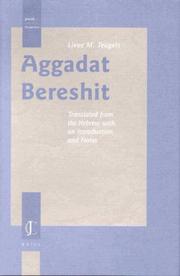
ISBN: 9004121730 9004421416 9789004121737 9789004421417 Year: 2001 Volume: 4 Publisher: Leiden, Netherlands : Brill,
Abstract | Keywords | Export | Availability | Bookmark
 Loading...
Loading...Choose an application
- Reference Manager
- EndNote
- RefWorks (Direct export to RefWorks)
Aggadat Bereshit is a homiletic Midrash on the Book of Genesis written in Hebrew, about the 10th century CE. It has a unique threefold structure, dividing the chapters or homilies according to the three parts of Tenakh : Torah (Genesis), Prophets and Writings. It contains interesting material, some unparalleled in rabbinic literature, such as an anti-Christian interpretation of Genesis 22. Besides being the first translation, this volume presents some variants from manuscripts unknown by its last editor (S. Buber, Krakow 1903). This English translation will be welcomed in the world of Jewish and Biblical Studies, academics as well as lay-persons with lesser knowledge of rabbinic Hebrew. The extensive introduction gives an up-to-date overview of the questions as to text, contents, structure, dating and provenance of this hitherto neglected Midrash.
Aggadat Bereshit (anglais). 2001 --- Bible --- 296*14 --- Moderne Haggadische verzamelingen --- 296*14 Moderne Haggadische verzamelingen --- Bible. --- Be-reshit (Book of the Old Testament) --- Bereshit (Book of the Old Testament) --- Bytie (Book of the Old Testament) --- Chʻangsegi (Book of the Old Testament) --- Genesis (Book of the Old Testament) --- Sifr al-Takwīn --- Takwīn (Book of the Old Testament) --- Bible. Genesis --- Sermons
Book
ISBN: 3727812753 9783727812750 Year: 2000 Volume: 43 Publisher: Freiburg Universitätsverl.
Abstract | Keywords | Export | Availability | Bookmark
 Loading...
Loading...Choose an application
- Reference Manager
- EndNote
- RefWorks (Direct export to RefWorks)
Merit (Jewish theology) --- Zekhut (The Hebrew word) --- 222.2 --- Merit of the fathers --- Genesis --- Midrash rabbah. --- Be-reshit rabah --- Bereshit rabah --- Bereshit rabba --- Genesis rabbah --- Ber. r. --- Genesis rabba --- Criticism, interpretation, etc. --- Hebrew language --- Jewish ethics --- Etymology --- Be-reshit raba --- Bereshit de-Rabbi Oshaya Rabbah --- Be-reshit de-Rabi Oshayah Rabah --- Be-reshit de-Rabi Hoshayah Rabah --- Genesis of R. Oshaya Rabbah --- Genesis of Rabbi Oshaya Rabbah --- Midrash Be-reshit rabah --- Midrash Be-reshit raba --- Agadat Erets Yiśraʼel --- מדרש בראשית רבה --- בראשית רבה --- מדרש בראשית רבא --- בראשית רבא --- בראשית דרבי אושעיה רבה --- בראשית דרבי הושעיה רבה --- אגדת ארץ ישראל
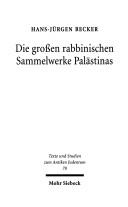
ISBN: 3161468678 9783161468674 Year: 1999 Volume: 70 Publisher: Tübingen Mohr Siebeck
Abstract | Keywords | Export | Availability | Bookmark
 Loading...
Loading...Choose an application
- Reference Manager
- EndNote
- RefWorks (Direct export to RefWorks)
Jewish religion --- Talmud --- Rabbinical literature --- History and criticism --- Talmud Yerushalmi --- Midrash rabbah. --- Comparative studies --- 296*134 --- 296*221 --- History and criticism. --- Midrasj Rabba op Pentateuch en Megillot: Beresjit Rabba--(o. m.) --- Talmud van Jeruzalem --- Be-reshit rabah --- Bereshit rabah --- Bereshit rabba --- Genesis rabbah --- Ber. r. --- Genesis rabba --- Jerusalem Talmud --- Palestinian Talmud --- Talmud, Jerusalem --- Talmud, Palestinian --- Jerusalemische Talmud --- Talmud de Jérusalem --- Yerushalmi (Talmud) --- Talmud ha-Maʻarav --- Comparative studies. --- 296*221 Talmud van Jeruzalem --- 296*134 Midrasj Rabba op Pentateuch en Megillot: Beresjit Rabba--(o. m.) --- Be-reshit raba --- Bereshit de-Rabbi Oshaya Rabbah --- Be-reshit de-Rabi Oshayah Rabah --- Be-reshit de-Rabi Hoshayah Rabah --- Genesis of R. Oshaya Rabbah --- Genesis of Rabbi Oshaya Rabbah --- Midrash Be-reshit rabah --- Midrash Be-reshit raba --- Agadat Erets Yiśraʼel --- מדרש בראשית רבה --- בראשית רבה --- מדרש בראשית רבא --- בראשית רבא --- בראשית דרבי אושעיה רבה --- בראשית דרבי הושעיה רבה --- אגדת ארץ ישראל --- Rabbinical literature - History and criticism
Book
ISBN: 1575064553 1575064545 9781575064543 Year: 2016 Publisher: Winona Lake, Indiana : Eisenbrauns,
Abstract | Keywords | Export | Availability | Bookmark
 Loading...
Loading...Choose an application
- Reference Manager
- EndNote
- RefWorks (Direct export to RefWorks)
The style of the Hebrew Bible has long been of significant interest to scholars and exegetes alike. Early Jewish and later Christian commentaries point out the importance of the exact wording in interpreting the text, and many an article has been written on features such as repetition and inclusio. With the rise of literary and narrative criticism in biblical studies, these features have received even more attention. The current book stands in the tradition of Robert Alter in that it focuses on how the text of Genesis is written and phrased. More explicitly, it is interested in why Genesis is formulated the way it is and how this affects the reader in his/her encounter with the text. Doubling and Duplicating is not only concerned with a style-as-analysis frame for interpreters but also with its role as a guide for any audience and its gateway to the ancient mind-set (ideological, ontological, and so on).All of the contributors to this collected volume focus on the form of the book of Genesis—that is, on its use of language and formulation. Yet, each author does this in his/her own way, depending on the most fitting tool for the specific research question or based on the researcher’s methodological background. Thus, the essays represent the various approaches in current literary and stylistic criticism as applied to the biblical corpus. Furthermore, the recurring duality of the features discussed in each of the contributions adds to the overall unity of the volume. This recurrence suggests the presence of a stylistic feature in the book of Genesis, the feature of doubling and duplicating, that surpasses the other features of the individual units or stories. This book offers insights about meaning-making on both the micro- and the macro-text levels.
Hebrew language
---
Jewish language
---
Jews
---
Semitic languages, Northwest
---
Parallelism
---
Languages
---
Bible.
---
Be-reshit (Book of the Old Testament)
---
Bereshit (Book of the Old Testament)
---
Bytie (Book of the Old Testament)
---
Chʻangsegi (Book of the Old Testament)
---
Genesis (Book of the Old Testament)
---
Sifr al-Takwīn
---
Takwīn (Book of the Old Testament)
---
Criticism, interpretation, etc.
---
Language, style
---
Literarischer Stil
---
Textkritik
---
Parallelism.
---
Bibel
---
Genesis
---
Bereshit
---
Berešit
---
Mose
---
Moses
---
Gen
---
Gn
---
Ge
---
<
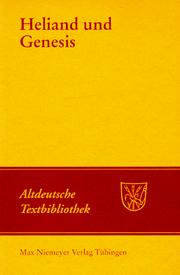
ISBN: 3484200030 3110963663 Year: 1996 Publisher: Tübingen Niemeyer
Abstract | Keywords | Export | Availability | Bookmark
 Loading...
Loading...Choose an application
- Reference Manager
- EndNote
- RefWorks (Direct export to RefWorks)
Entstanden vor/um Mitte des 9. Jahrhunderts, sind der altsächsische »Heliand« (eine dichterische Nacherzählung des Lebens Christi) und die fragmentarisch erhaltene altsächsische »Genesis« die ersten großepischen Zeugnisse des deutschen Sprachraums. Sie verbinden die Gattungstradition der spätantik-frühchristilichen Bibelepik mit der Formtradition germanischer Stabreimdichtung.
German literature --- Bible. O.T. Genesis --- History of Biblical events --- Poetry --- Bible. --- LITERARY COLLECTIONS / Medieval. --- Be-reshit (Book of the Old Testament) --- Bereshit (Book of the Old Testament) --- Bytie (Book of the Old Testament) --- Chʻangsegi (Book of the Old Testament) --- Genesis (Book of the Old Testament) --- Sifr al-Takwīn --- Takwīn (Book of the Old Testament) --- Poetry.
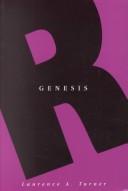
ISBN: 1841270342 9781841270340 Year: 2000 Publisher: Sheffield Sheffield Academic Press
Abstract | Keywords | Export | Availability | Bookmark
 Loading...
Loading...Choose an application
- Reference Manager
- EndNote
- RefWorks (Direct export to RefWorks)
Bible OT. Pentateuch. Genesis --- Bible --- 222.2 --- Genesis --- Bible. --- Be-reshit (Book of the Old Testament) --- Bereshit (Book of the Old Testament) --- Bytie (Book of the Old Testament) --- Chʻangsegi (Book of the Old Testament) --- Genesis (Book of the Old Testament) --- Sifr al-Takwīn --- Takwīn (Book of the Old Testament)
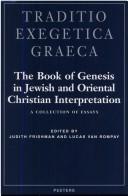
ISBN: 9068319205 9789068319200 Year: 1997 Volume: 5 Publisher: Lovanii Peeters
Abstract | Keywords | Export | Availability | Bookmark
 Loading...
Loading...Choose an application
- Reference Manager
- EndNote
- RefWorks (Direct export to RefWorks)
Ancien Testament --- Oude Testament --- Bible --- 222.2 --- Genesis --- Bible. --- Be-reshit (Book of the Old Testament) --- Bereshit (Book of the Old Testament) --- Bytie (Book of the Old Testament) --- Chʻangsegi (Book of the Old Testament) --- Genesis (Book of the Old Testament) --- Sifr al-Takwīn --- Takwīn (Book of the Old Testament) --- Commentaries.
Book
ISBN: 9789004191693 9004191690 9789004214705 9004214704 1283120283 9786613120281 Year: 2011 Volume: 106 Publisher: Boston Brill
Abstract | Keywords | Export | Availability | Bookmark
 Loading...
Loading...Choose an application
- Reference Manager
- EndNote
- RefWorks (Direct export to RefWorks)
Sojourn is a Leitwort in the ancestral narratives of Genesis, repeatedly accentuated as an important descriptor of the patriarchs’ identity and experience. This study shows that despite its connotations of alienation, sojourn language in Genesis contributes to a strong communal identity for biblical Israel. An innovative application of Anthony D. Smith’s theory of ethnic myth utilizes the categories of ethnoscape, election, and communal ethics as analytical tools in the investigation of the Genesis sojourn texts. Close exegetical treatment reveals sojourn to strengthen Israel’s ethnic identity in ways that are varied and at times paradoxical. Its very complexity, however, makes it particularly useful as a resource for group identity at times when straightforward categories of territorial and social affiliation may fail.
222.2 --- Genesis --- Bible. --- Be-reshit (Book of the Old Testament) --- Bereshit (Book of the Old Testament) --- Bytie (Book of the Old Testament) --- Chʻangsegi (Book of the Old Testament) --- Genesis (Book of the Old Testament) --- Sifr al-Takwīn --- Takwīn (Book of the Old Testament) --- Criticism, Narrative. --- Bible
Book
ISBN: 9789004226531 9789004226579 9004226575 9004226532 1280496339 9786613591562 Year: 2012 Volume: 152 Publisher: Leiden ; Boston : Brill,
Abstract | Keywords | Export | Availability | Bookmark
 Loading...
Loading...Choose an application
- Reference Manager
- EndNote
- RefWorks (Direct export to RefWorks)
Written by leading experts in the field, The Book of Genesis: Composition, Reception, and Interpretation offers a wide-ranging treatment of the main aspects of Genesis study. Its twenty-nine essays fall under four main sections. The first section contains studies of a more general nature, including the history of Genesis in critical study, Genesis in literary and historical study, as well as the function of Genesis in the Pentateuch. In the second portion, scholars present commentary on or interpretation of specific passages (or sections) of Genesis, as well as essays on its formation, genres, and themes. The third part includes essays on the textual history and reception of Genesis in Judaism, Christianity, and Islam. The final section explores the theologies of the book of Genesis, including essays on Genesis and ecology and Genesis in the context of Jewish thought.
Bible --- Criticism, interpretation, etc --- 222.2 --- Genesis --- Bible. --- Be-reshit (Book of the Old Testament) --- Bereshit (Book of the Old Testament) --- Bytie (Book of the Old Testament) --- Chʻangsegi (Book of the Old Testament) --- Genesis (Book of the Old Testament) --- Sifr al-Takwīn --- Takwīn (Book of the Old Testament) --- Criticism, interpretation, etc. --- Religion. --- Criticism, Textual. --- Criticism, Redaction. --- Versions.
Book
ISSN: 07501919 ISBN: 2204080497 9782204080491 Year: 2006 Volume: 208 Publisher: Paris Cerf
Abstract | Keywords | Export | Availability | Bookmark
 Loading...
Loading...Choose an application
- Reference Manager
- EndNote
- RefWorks (Direct export to RefWorks)
Il s'agit ici de traverser la Genèse comme qui traverserait le Pacifique à la rame : en profitant de chaque vague. Le livre est volumineux ? Comme son lecteur n'est pas obligé de le lire d'un trait et en suivant, mais peut l'aborder par telle ou telle page – la Création, mais aussi bien Abraham, Noé ou Joseph... –, chaque section fournit un regard sur l'ensemble et l'on n'a pas économisé les reprises. Paradoxalement, la lecture en devient plus confortable. Un jour, les belles traditions historiques, des légendes, voire de vieux mythes, ont été rassemblés pour les Judéens revenus d'exil. On pouvait être tenté de réveiller en eux l'orgueil nationaliste et, par exemple, le désir d'indépendance ou celui d'une royauté. Mais le livre de la Genèse leur propose au contraire un tableau des origines des Nations et d'Israël plus nuancé. L'homme est blessé. Israël est blessé, et si l'on annonce son rôle parmi toutes les Nations, ce sera celui du service : Joseph et ses frères finissent exilés en Égypte. Les rois désirent deux choses, un bon territoire et un fils aîné ? La Genèse écarte l'un et l'autre au profit d'une sorte d'abdication : elle veut purger en l'homme la volonté de puissance. Le vide ainsi obtenu est alors rempli de l'heureuse Présence de Dieu et du frère. Ce que les Prophètes disent d'une voix terrible, la Genèse le monnaie avec lenteur, par des récits à la fois populaires et sages. Et les vieilles légendes, les mythes, les souvenirs historiques sont reliés, patinés, unifiés par une conscience littéraire très sûre. C'est précisément cette finesse, cet art simple et subtil en même temps, que « Le partage de minuit » voudrait donner à saisir
Bible. --- Criticism, interpretation, etc. --- Bible --- Criticism, interpretation, etc --- Bible studies --- Old testament --- 222.2 --- Genesis --- Bible OT. Pentateuch. Genesis --- Be-reshit (Book of the Old Testament) --- Bereshit (Book of the Old Testament) --- Bytie (Book of the Old Testament) --- Chʻangsegi (Book of the Old Testament) --- Genesis (Book of the Old Testament) --- Sifr al-Takwīn --- Takwīn (Book of the Old Testament)
| Listing 1 - 10 of 196 | << page >> |
Sort by
|

 Search
Search Feedback
Feedback About UniCat
About UniCat  Help
Help News
News